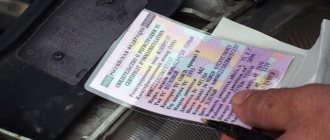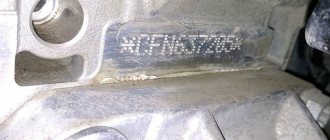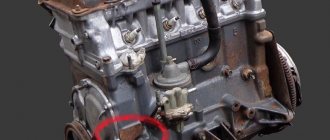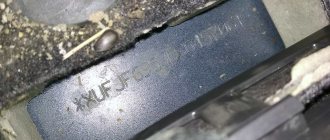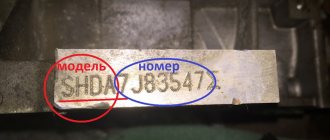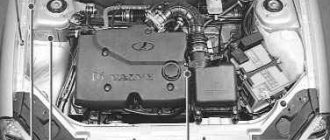Where is the number located in foreign cars, Russian cars, trucks
The Russian manufacturer of trucks and passenger cars uses the engine code not only to mark it, but also as an identifier of the unit. Therefore, the engine number is recorded in the vehicle title and stamped on the internal combustion engine itself. For most domestically produced cars, it is on the left side of the cylinder block.
The foreign automaker classifies the engine as a replacement part and uses the number only as a repair indicator. Foreign cars are not identified by engine code. The vehicle history is checked using the VIN.
There is no single standard for where a car's engine number should be located. The digital designation for foreign cars can be stamped directly on the power unit or on a duplicate plate in the engine compartment.
Engine number Passat B5
Good morning everyone. Please tell a newbie where the ADR engine number is, show the car to the police in an hour!
Apparently I'm a little late with the number :)
Yes, I already found it myself (you have to hide it like that.). Anyway, thanks for welcoming me to Passatovody. And the policeman didn’t seem to care about the number, he was cold, poor fellow.
1.8 ARG (top with engine error) 125 hp sedan, front xenon, rear tuning lights. To be honest, I’m not a big fan of tuning, I like the stock ones better, but as they say, whichever one I got.
I looked at www.exist.ru and it seems there is a catalog number for the correct mirror. I want to try to order. You can also look at Skoda there.
My 1998 B5, in the Trend configuration, also only had a heated left mirror, and then they told me that this was correct, like both mirrors can be heated, and only the left one.
Please indicate the location of the VW Passat B5 1.6 AHL engine number (if available, with a picture)
ACHTUNG: It’s better to do it in the morning, on a cold engine, otherwise it won’t take long to burn all your hands.
Guys, psst. I can’t register the Passat. First, the traffic cop and I rubbed the entire engine with rags and sticks, then at two more stations (though not branded ones), then I climbed under the car alone. I can’t find the ENGINE NUMBER (((AHL motor. If there is any information about its whereabouts, please tweet, otherwise I’m already driving from traffic cop to traffic cop, collecting fines for overdue transits(((
Thank you))) I’ll scour tomorrow! It’s strange that the traffic cops don’t know this.
That’s right, you can use a synthetic high-temperature lubricant or a special compound and clean off the old lubricant and apply a new one once a year/half a year, depending on use.
I read and remember how I registered the soy! GUY me three times. sent! )))
After cleaning (it’s better to clean it not with a metal object, but with a rust converter) and reading it with a nut, you can coat it with any anti-corrosive agent (even Movil)
There was such a situation, I had to go to the engine wash, the guy didn’t want to identify the number, it’s stamped with dots. motor aev. The room is actually in the same type.
On awt it is also not visible, and washing is often powerless
covered it with graphite grease (that cleaning specialist at the traffic police advised) after cleaning the wd. but I covered it up, it sucks, the engine hasn’t cooled down yet, so after the rains I’ll take a look, maybe I’ll cover it with plain lithol
Source
Where to look
There are several places where you can look up the engine number on a car. Reconciliation of the stamped code and the code indicated in the database will be an additional guarantee that the original internal combustion engine is installed on the vehicle. The one that was offered by the manufacturer as the optimal power unit for a particular car.
When inspecting the vehicle
In addition to the documents for the car (PTS and registration certificate), the car’s engine number is located on the unit itself. Most often on the side or top of the block head. But different brands may have their own individual places that the manufacturer has determined for marking. You can find it after a thorough inspection of the unit and adjacent components. Typically the identifier is located at:
- the junction of the internal combustion engine and the transmission shaft (as on the Audi A4, Volkswagen Golf, Passat, Skoda Fabia, etc.);
- timing belt casing;
- manifold (intake, radiator cooling);
- near the dipstick to determine the oil level (as on a Chevrolet Lanos, for example).
Very rarely - on the wheel arch, as in Land Cruisers.
Where is the engine number on a VAZ 2112 car?
On cars that are more than 10 years old and on trucks, it can be difficult to see the markings due to corrosion of the metal plate: the stamped number may be partially erased. In this case, it is recommended to calculate the internal combustion engine identifier using operational documents.
For example, the Mercedes brand for its models, regardless of the year of manufacture, stamps the identifier on a plate, which is installed above the engine mount bracket on the left. Some car models before 2005 have a code stamped on the cylinder head on the rear wall. For Mercedes diesel engines, the plate is always on the left.
For all VAZ models, starting from 2101 to 2107, the engine number is stamped between the third and fourth spark plugs.
By VIN code
The VIN code can only decipher the class and type of engine. To find out whether the original internal combustion engine is on the car or a contract one after repair, you need to check the manufacturer’s database and information from the technical. documentation for a specific model.
Vehicle VIN code
The second part of the VIN code is responsible for the technical characteristics of the vehicle, which consists of 6 characters and refers to the descriptive part. The indicated fifth character symbol indicates the type and model of the motor, but does not carry information about the identification serial number of the assembly team.
Through the traffic police
Using the traffic police database, you can find out by the engine number whether the car has been stolen or not. The check is carried out online, free of charge. The traffic police database provides complete information about whether a car with such an engine is listed as stolen if the car is officially registered in the country.
On American-made engines, there are no stamped codes on the power unit. Therefore, you will need to check the car for theft by matching the VIN code on the car and in the title.
Information about whether the car has the original engine or whether the unit has been replaced cannot be found out from this database.
Through specialized services
You can find out the data on the car engine through specialized online services: “Autocode”, “Autobot”. Services provided include deciphering the vehicle’s VIN code, providing data on the specific model and units that the vehicle was equipped with from the factory.
Online service "Autocode"
You can find out the original number of the internal combustion engine through the catalogs of online spare parts stores. The VIN is entered into the specified form, the form of additional information about the car is filled out - after 10-15 minutes the form with catalog spare parts and codes of original components opens.
How to find out the engine model by VIN code?
There are many situations when you simply need to find out the engine model. For example, when buying a car or just spare parts. And then the question arises: how and where to get this information? Next, we will tell you how to determine the engine model in the following ways: find the number on the engine using the engine compartment plate and the VIN code.
On the engine itself
Let's say right away that looking for the number on the engine is not the easiest way. Although, it would seem: he opened the hood, found the engine, found the number and entered it into the search engine. But it's not that simple.
Where is the engine number
Firstly, the number can be stamped on a variety of places on the engine. It all depends on the make and model of the car. Although more often it can be found on the top part, the one closer to the windshield. Well, secondly, the number itself may be in such a state that it is impossible to figure it out without a rust remover and a brush, or even completely destroyed by corrosion.
What information is written there?
Once you have found the engine number, you can begin to parse the information that it represents. Although, depending on the brand, there are some differences, the markings generally consist of 14 characters. They are conventionally divided into two blocks: descriptive (6) and indicative (8).
Pay attention to the first one. The first three digits in the descriptive block indicate the base model index. This is followed by the modification index (if there is none, put zero), climate version and either the Latin “A” (meaning diaphragm clutch) or “P” (recirculation valve). In the index part, the year of manufacture is first indicated (by a number or letter of the Latin alphabet), then the month (by the next two digits). The remaining 5 characters indicate the serial number.
Remember! Numbers from 1 to 9 indicate the years of manufacture 2001-2009, Latin “A” - 2010, B - 2011, C - 2012, etc.
Sign under the hood
We will tell you further how to find out the engine model by wine, and now let’s pay attention to the plate on which this is also indicated. It is located under the hood of most passenger cars and is called the engine compartment. Using numbers and letters, all the necessary information is provided here (car model, engine type, cylinder capacity, frame number or identification number, color code and trim code, drive axle, manufacturer and type of transmission). Depending on the make of the car, it may be supplied in different sequences. To decrypt, you will have to use special literature or appropriate resources.
Find out the engine by VIN code
The third method will explain how to find out the engine model by VIN code. Vehicle Identification Number, abbreviated as VIN. They began assigning this number to cars in America and Canada. This is a unique identification number consisting of 17 numbers and letters. With its help you can find out almost everything about a particular car. And, of course, there is information about the engine model. It is enough to look at the car’s registration certificate to find out the data (from the year of modification to the code) of the engine by vin.
Although you can do without it by looking at the code on the machine itself. Since there are no strict rules for the location of the VIN code, it can also be seen near the passenger seat. But more often it is located between the windshield and the engine.
The VIN code is divided into 3 parts of three, six and eight characters. Only numbers and Latin letters are used (except I, O, Q due to the similarity with numbers). The first speaks about the manufacturer, the second describes the vehicle, the third is distinctive.
An example of an engine number and its interpretation
Russian manufacturers mark their engines in accordance with their own regulations. The same is true for units made in Europe and America.
For American cars
American cars do not have an engine code; the manufacturer does not identify its units in any way. Only the class and type are specified. For example, it additionally indicates the compatibility of the engine with other models.
All information about the configuration can be found only by the VIN code, in the descriptive and special part of which the following are encrypted:
- country and manufacturer;
- class and type of internal combustion engine;
- Date of issue.
Engine number on a Ford Focus car
Based on these data, the selection of internal combustion engines for repairs is carried out. The current situation is due to the fact that in the United States this type of criminal business, such as selling cars for spare parts, is not common. High insurance covers the owner's expenses if the car is stolen or involved in an accident. Therefore, disassembling a car for spare parts is unprofitable.
For European
On European units, identifiers are stamped in two places: at the junction of the engine and gearbox, on the cylinder block. For Volkswagen models, the manufacturer has defined nine- and eight-digit markings: the first two or three letters and six numbers, which indicate the engine equipment, power, torque and type of fuel used.
Engine number on a Volkswagen car
An example of a 2010 Volkswagen Passat engine number: VRL008264. The sign is knocked out with a special needle directly on the head of the blocks. The same set of symbols is indicated on duplicate plates located on the body and in the engine compartment. A similar number is recorded in the technical documentation.
For the Russian Federation
The leader in the production of domestic passenger cars, the AvtoVAZ company, marks its engines with a fifteen-digit code, which indicates the specific configuration, dates (month and year) of block casting and assembly of the unit. The internal combustion engine number on a VAZ looks like this: FVAZ06 10 82 K 2103. Explanation:
- F (A, B, C, D, N) - the technique used or method of manufacturing the motor;
- VAZ - plant (headquarters or branches);
- 06 10 82 - block casting date
- 2103 - type and model of motor;
- K - code of the manufacturer's team.
This marking is most convenient when passing quality control and when selecting a repair kit.
The KAMAZ manufacturer marks its internal combustion engines with plates indicating the engine model and the full code, which is stamped directly on the block and consists of 15 characters. They are always applied in two lines using the impact method between the main supports.
Plate with engine number for Kamaz
Decoding of the car engine number 740622 Х ХХХХХХХХ:
- 740 - code of the basic internal combustion engine model;
- 622 - modification of the motor;
- X – release date;
- ХХХХХХХХ – identifier.
For Korean and Japanese cars
Korean and Japanese engine markings remain the most informative for the driver. In addition to the unit identification number, the code indicates power, torque, aggregation by adjacent units, fuel type, injection system and much more.
For the Toyota brand, on the company’s official page you can see complete information about the car, service intervals, the presence or absence of repair kits, and catalog numbers of any part. For example, the internal combustion engine code on a Toyota Prado consists of 12 characters (Latin letters and numbers) and gives the following information:
- a specific number of internal combustion engines in the series;
- motor series code;
- features of the block head, presence/absence of forces;
- power;
- presence/absence of a turbocharger;
- type of injection;
- fuel type;
- definition of a hybrid power plant;
- type of fuel supply system.
Toyota car engine number
The engine number is stamped directly on the racks of the unit and is duplicated in the vehicle certificate and technical documentation.
Passat B3 Which Engine is Better
Volkswagen Passat B3 cars, despite the fact that they have been produced for many years, are still popular both in the European and Russian markets. The high sales results of these cars can be explained quite simply - the cars have excellent dynamics, excellent technical characteristics and features, excellent engines in all trim levels, including the basic one. The equipment of the Passat B3 cars, their exterior and interior attract the buyer with their sophistication and sophistication, as well as moderately aggressive features. However, the part that interests drivers the most is, of course, the engine. And in this article we will look at the operation of a Passat B3 car with a 2e injection engine.
Will be useful By 2021 there could be 20,000 running jaguars on the road
Why might you need a car engine number?
If the VIN number allows you to fully identify the car, then the engine number helps to further protect the owner when purchasing and ensures quick and correct selection of spare parts
When buying/selling
The traffic police pays special attention to the presence of the VIN code and the coincidence of the markings on the body and in the title. But in addition to the VIN, the engine, frame or chassis number is also recorded in the registration certificate. This allows you to protect the future owner when purchasing a car. The coincidence of all numbers guarantees that the car was not stolen and was not assembled in parts.
The engine number is checked upon purchase in order to:
- make sure that internal combustion engines with such characteristics can be operated in the country;
- check if the car is stolen or parts are stolen.
Each engine has a unique marking. Therefore, the power unit can be identified by number, which is what is done when registering the car.
Replacement of internal combustion engine or selection of spare parts
Replacing the internal combustion engine with a contract one is carried out after the standard unit has exhausted its service life and cannot be overhauled. In this case, using the code of the original engine, it is easy to select a similar unit that was installed on the car model range in certain years.
After reinstalling the internal combustion engine, the owner needs to reissue the registration certificate at the State Traffic Safety Inspectorate and enter into the documentation the number of the new engine that is now in the car.
DemonXD › Blog › Review of Passat B3 engines (88-93 years of production) and B4 (94-96 years)
About one and a half dozen gasoline engines with power from 72 to 184 hp, and five diesel engines with 68-110 hp were installed on the Passat B3 and B4. Because I haven’t had to deal with diesel engines, I’ll only consider gasoline models. In general, VW engines are very durable and, with proper operation, run 300-400 thousand km without serious intervention. The main thing is to change the oil on time and use only high-quality oil, preferably with VW approval; do not allow the engine to overheat; use VW G11 or G12 antifreeze as a coolant (incompatible with each other!), because domestic Antifreeze (similar to G11) is most often substandard and often actually corrodes engine parts and damages the coolant pump; change the timing belt (chain) in a timely manner - its breakage usually leads to the valves meeting the pistons. Typical problems with used Passat engines include the following: Increased oil consumption due to wear of valve stem seals, oil leakage through the valve cover gasket, leaks in the cooling system, especially as a result of cracks in the plastic “tee” on the front of the engine, with untimely oil changes and If it is of poor quality, the hydraulic valve compensators begin to knock (a short knock after starting a cold engine is acceptable). Without pretending to be comprehensive, I will briefly consider the most common VW Passat engines of the B3 (88-93) and B4 (94-96) models. The period for installing the engine on the Passat is indicated in parentheses after the code. To begin with, I note that in order to determine the engine code of the Passat (as well as other VW). You just need to look at the engine number, the one that is written in the registration certificate. The first two or three letters, or a number and a letter, with which the number begins is its code. 1. 8 valve engines. 1.1 Carburetor engines.
RF
(4.88-7.89): 1.6 liters, 2E3 type carburetor, power 72 hp, torque 120 Nm/2700 rpm, 91 gasoline.
EZ/ABN (8.88-9.93)
: 1.6 liters, 2E3 type carburetor, power 75 hp, torque 125 Nm/2600 rpm, 91 gasoline. Obviously weak engines for a rather large car. A semi-automatic carburetor is far from easy to repair and adjust, and problems at this age are not uncommon. As a last resort, it is possible to convert it to a Solex carburetor from a front-wheel drive VAZ (cost of spare parts + labor is approximately $100). Cars with such engines are usually “empty” in configuration. I don't recommend buying it.
1.2 Single injection engines.
RP (4.88-7.91)
: 1.8 liters, mono-injection “Monojetronic” (in ’91 – Monomotronic), 90 hp, 142 Nm/3000 rpm, 91 petrol, catalyst.
ABS (8.91-9.94)/ADZ (10.94-9.96)
: 1.8 liters, mono-injection “Monomotronic” 90 hp, 145 Nm / 2500 rpm, 95 gasoline, catalyst.
AAM (8.90-9.96): 1.8 liters
, mono-injection “Monomotronic”, 75 hp, 140 Nm/2500 rpm, 91 gasoline, catalyst.
Deformed version of the “ABS” motor. Single injection engines are most often found on Passats. All of them are reliable, unpretentious and durable, workhorses, so to speak. But due to the low power, the dynamic performance of the Passat with them is not too high (especially with the AAM engine). Suitable for relatively quiet driving. Relatively typical problems with these engines include rupture of the rubber gasket between the injection and intake manifold (unstable operation, dips) and breakdown of the idle speed sensor and throttle positioner (unstable idle). They have built-in self-diagnosis, so you can view fault codes using the VAG 1552 device, or simply with an LED based on the number of flashes (for Monojetronic). It will be useful: How to clean the throttle valve of a VAZ 2110 injector
1.3 Engines with distributed injection.
PF (4.88-7.90)
: 1.8 liters, “Digifant” injection, 107 hp, 154 Nm/3800 rpm, 95 gasoline, catalyst.
PB (4.88-7.90)
: 1.8 liters, “Digifant” injection, 112 hp, 159 Nm/4000 rpm, 98 gasoline, differs from PF in the absence of a catalyst and lambda probe.
2E (3.90-9.94)
: 2 liters, “Digifant” injection, 115 hp, 166 Nm /3200 rpm, 95 gasoline, catalyst.
On the Passat B4 they also installed: ADY (10.94-7.95)
: 2 liters, Simos injection, 115 hp, 166 Nm/3200 rpm, 95 gasoline, catalyst.
AGG (8.95-9.96)
: 2 liters, Simos injection, 115 hp, 166 Nm/2600 rpm, 95 petrol, catalyst. In my opinion, engines are more suitable for the Passat compared to single-injection ones. The Digifant (electronic) injection is designed simply, there is practically nothing to break there. 2E is generally one of the most successful VW engines of the early 90s. The Passat with it allows you to feel quite confident on the road (11.5 seconds up to 100 mph, 195 mph top speed), and at the same time is simple and cheap to maintain. Problems: most often, unstable idling occurs due to the fault of the xx sensor or regulator. I would include the following point among the design flaws (applies to the PF/PB engines, I can’t say for sure about the 2E): the mass between the battery and the engine is attached to the engine with a gearbox bolt. When unscrewing it (for example, replacing a clutch), it happens that they forget to put this wire in place, and when they try to start the engine, the entire starter current goes through the injection controller, which burns out. But in reality it’s not so scary, because... parts that have failed (for example, an 80C39 processor) are easily bought on the radio market and cost pennies. I also note that Digifant control units produced before August 1992 did not have self-diagnosis.
2. 16-valve engines.
On Passat B3:
KR (7.88-9.93)
: 1.8 liters, mechanical injection “K-Jetronic”, 136 hp, 162 Nm/4800 rpm, 98 petrol.
9A (7.88-9-93)
: 2 liters, “KE-Motronic” injection, 136 hp, 180 Nm/4400 rpm, 95 gasoline, catalyst.
KE-Motronic is actually a modernized K-Jetronic, with an electronic control unit that processes the lambda probe signal and adjusts the ignition timing. KR is rare, but 9A is quite common. Cars with it are usually well equipped (GT, power accessories, often air conditioning, automatic transmission). In principle, the engine is not bad, but it is more capricious compared to 8-valve engines, repair and maintenance are more expensive and more difficult, and not everyone will take it on. Typical problems: unstable xx on early releases (can be treated by replacing the firmware), oil leakage from the distributor seal. Because The injection is based on a mechanical one, two electric fuel pumps are installed, the pressure in the fuel line is 6 atm. The engine is “hot” (the coolant temperature can reach up to 110 degrees), especially if there is air conditioning and an automatic transmission, so it is demanding on the health of the cooling system. On Passat B4: ABF (10.93-9.96)
: 2 liters, Digifant injection, 150 hp, 180 Nm/4800 rpm, 95 gasoline, catalyst.
Passats with this engine are rare, and finding a “live” one in Russia is extremely difficult. 3. For those who like “hot things”. PG (10.88-9.93)
: 1.8 liters, 8 valves, “Digifant” injection, G60 mechanical supercharger, 160 hp, 225 Nm/4000 rpm, 95 petrol.
Installed on cars of the all-wheel drive version of Passat-Syncro. And finally, the most powerful engines on the Passat B3 and B4 are VR6. They have 6 cylinders arranged in a V-shape, but with a small camber angle, a cylinder head - one common for all cylinders, two camshafts, two valves per cylinder. Injection – Motronic. AAA (10.90-9.96)
: 2.8 liters, 174 hp, 235 Nm / 4200 rpm, 95 petrol.
ABV (9.93-9.96)
: 2.9 liters, 184 hp, 245 Nm/4200 rpm, 98 petrol. The advantages of Passats with these engines are obvious - good dynamics and maximum speed. The Passat VR6 accelerates to hundreds in 8.5 seconds and reaches 225 mph. The equipment of powerful Passats is usually maximum. Well, what will you have to pay for it? Firstly, higher fuel consumption (for VR6 12-20 liters per 100 km). Secondly, these motors are more complex and expensive to maintain and repair. I don’t want to say that they are distinguished by some special brittleness, but anything can happen. And when purchasing a car, you should think about possible problems and their solutions. For example, a failure of the G60 supercharger will result in only 70-80 hp remaining from 160, and a new supercharger costs about $2000. The VR6 engine requires replacement of the timing chain every 150 tkm; failure to comply with this rule can lead to a serious engine failure. Overhaul of the VR6 can easily cost $3,000. In addition, if you can at least “climb under the hood of a car with a 1.8 engine,” then the VR6 has a very tight layout of the engine compartment, and, for example, such a simple operation as replacing the coolant pump according to the company’s instructions requires removing the engine from the car (true craftsmen do without this J) Due to the large mass of the engine, reinforced parts are used in the front suspension, which are more expensive than standard ones. And of course, the “sophisticated” versions of the Passat are noticeably more expensive on the market and it is more difficult to find an “unkilled” car.
In general, my summary: 1.8 engines with single injection (RP, ABS, ADZ) 90 hp are suitable for relatively quiet driving, economical and cheap to operate. But first of all, I recommend the 2E engine (ADY, AGG), or, as a more powerful option, 9A. The Passat with them is more dynamic, and the costs are comparable (2E) or slightly higher (9A) in comparison with single injection. Well, for those for whom speed is more important than money - PG and VR6. Publication date 2008
What to do if there is no unit number
Problems with the lack of ICE markings arise if you have to register cars from an American manufacturer. Since the traffic police examination requires the presence of this code. In such cases, the technical documentation for the vehicle states that the unit is not numbered.
When purchasing a car without an internal combustion engine code, you must check with the real owner for the reason for the absence and additionally check the vehicle for theft and fair ownership. There may be no engine number if the internal combustion engine was damaged in an accident and was repaired manually.
